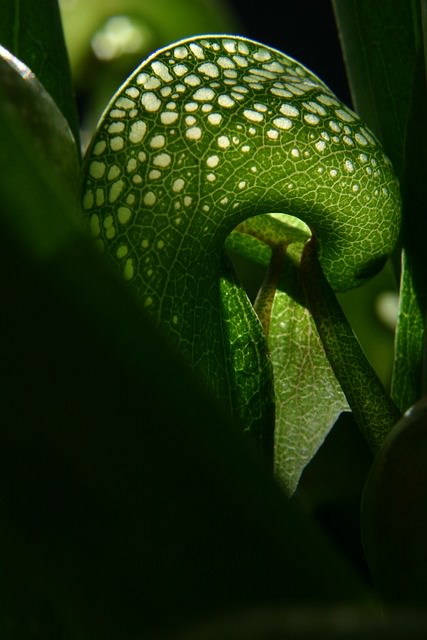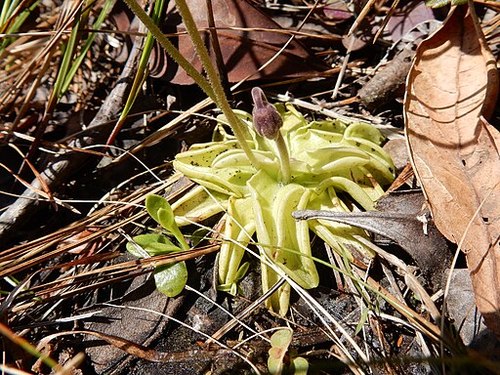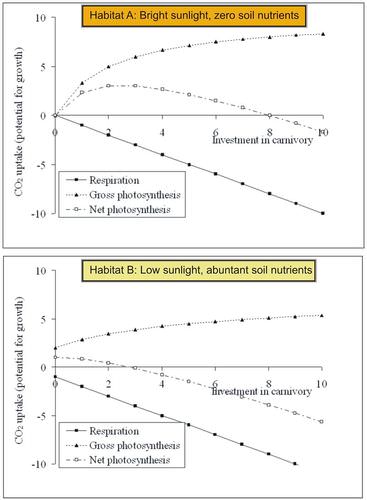13.56 食肉植物 -- -- 高级
章节大纲
-
Carnivorous Plants: Competing for Nutrients
::食肉植物:营养物质竞争The idea of a plant eating an has always fascinated people, from “pet” Venus Flytraps ( Figure ) to “Audrey, Jr.” in the Broadway musical, Little Shop of Horrors – or the Whomping Willow of the Harry Potter series. Inevitably, intrigued biology students suggest that such unique plants play the role of consumers, rather than , in their . Indeed, the general name for this group of plants – carnivore – supports this hypothesis . However, no known plant obtains a majority of its energy from the animals – usually , other , or – it “eats”. What are the benefits of carnivory among plants? What kinds of adaptations allow plants to capture animals? These questions are the focus of this last section of the lesson.
::在百老汇音乐会、小恐怖小商店 — — 或者《哈利波特》系列的《Whomping Willow 》 中,食用一种植物的想法总是让人着迷,从“贝特”金星飞禽(Fubre)到“Audrey, Jr ” ( Audrey, Jr ) 。 不可避免,奇特的生物学学生们认为,这种独特的植物在它们中扮演着消费者的角色,而不是消费者的角色。 事实上,这组植物的普通名称 — — 食肉动物 — — 支持这一假设。 然而,没有已知的植物从动物中获取大部分能量 — — 通常是其他植物,还是“食用 ” 。 植物之间的肉食有什么好处? 什么样的适应让植物捕捉动物? 这些问题是最后一部分教训的重点。The Venus Flytrap captures, digests, and absorbs nutrients from insects. However, note that both plant and trap are green and photosynthetic. Carnivorous plants depend on the nutrients – but not the energy – of their prey. Carnivorous “behavior” is clearly adaptive in some way; it is surprisingly common among plants. About 625 are truly carnivorous plants (usually insectivorous plants ) - able to attract and trap prey , secrete digestive , and absorb digested nutrients . Some 300 more are protocarnivorous plants , able to trap and kill prey but lacking either enzymes or the ability to absorb the nutrients. True carnivory may have evolved independently in ten different plant groups, now characterizing 12 genera in 5 families. Types of traps fall into five basic categories:
::食肉动物“行为”显然在某些方面具有适应性;在植物中是令人惊讶的常见现象。大约625种是真正的食肉植物(通常是食虫植物),能够吸引和捕捉猎物、秘密消化和吸收消化养分。还有大约300种是食肉植物,能够捕捉和杀死猎物,但却缺乏酶或吸收养分的能力。真正的食肉动物可能在10个不同的植物组中独立演变,现在在5个家庭中有12个基因组。捕食的种类分为5个基本类别:-
Pitfall Traps
::地瀑布陷阱 -
Flypaper Traps
::Flypaper 陷阱 -
Snap Traps
::快速陷阱 -
Bladder
Traps
::Bradder 陷阱 -
Lobster-pot Traps
::龙虾锅陷阱
Pitfall Traps
::地瀑布陷阱Pitfall Traps are modified, rolled leaves, sealed at their edges, which contain a pool of digestive enzymes and/or .
::孔隙陷阱被修改、滚动叶片,在边缘密封,其中含有大量消化酶和/或。Pitcher plants are well-known New World examples – perhaps the simplest of the pitfall varieties. The South American marsh pitcher ( Figure ) has rolled leaves that trap and harbor symbiotic bacteria which secrete the necessary digestive enzymes. A “ nectar spoon” secretes sugars, which attract insect prey, and downward pointing hairs restrict their exit. Slippery, waxy flakes line the cups, helping to prevent prey escape. An overflow slit maintains a constant level of water.
::捕食者植物是众所周知的新世界例子 — — 也许是最简单的陷阱品种。 南美沼泽投手(Figure)把树叶卷起,并窝藏了隐藏了必要消化酶的共生细菌(共生细菌 ) 。 一种“新勺子”秘密糖,它吸引了昆虫猎物,而下角毛则限制了它们的出口。 滑动,蜡状的片片片排在杯子上,帮助防止猎物逃逸。 溢出层保持了恒定的水量。The dramatic Cobra Lily ( Figure ) shelters its pitcher from rainfall with a large, mottled hood and two “fangs”. Cobra lilies do not secrete digestive enzymes, but rely on bacteria to break down prey. Lining identical to root cells absorb the bacteria-digested nutrients. Mottled coloration creates patterns of light, which appear to prey as “false exits”; the insects finally tire of trying to find a way out, and fall into the trap.
::戏剧性的Cobra Lily (Figore)在雨中掩藏着一个巨大的、被磨碎的兜帽和两个“fang”的投手。 眼镜蛇的百合不会秘密消化酶,而是依靠细菌来打破猎物。 根细胞的边缘吸收了被细菌吸收的养分。 调色造成了光线的形态,猎物看起来像是“假出口 ” ; 昆虫终于厌倦了寻找出路的方法,并落入陷阱。Pitfall traps attract, trap, and digest prey for Cobra Lily. The largest pitcher plants are monkey cups of the genus Nepenthes . N. rajah ( Figure ) inhabits serpentine soils, low in nitrogen, phosphorus and calcium/magnesium and toxic to many plant species. N. rajah produces a huge urn up to 40 cm (16 in) tall, 18 cm (7 in) wide, and 2.5 liters (2/3 gallon) in volume of digestive fluid. This vine-like species suspends its urns from strong “tendrils”, but larger urns rest on the ground. Nectar-secreting glands cover the pitcher, and digestive glands line the interior. N. rajah is famous for trapping small , , and mammals , although its main “diet” is insects. A number of species of insects, spider, and even a crab inhabit the urn safe from digestion ; some are not known to survive anywhere except in this species. Many biologists believe that these symbioses are mutually beneficial; the animals receive habitat , protection, and prey, and the plant receives help with digestion, reduced bacteria, and increased nutrient availability.
::N. Rajah生产巨型乌轮,最多40厘米(16厘米)高,18厘米(7厘米宽)和2.5升(2/3加仑)的消化液。这些类似葡萄的物种将它的泌尿量从强力的“十头”中延缓下来,但更大的栖息于地下。内地的硝酸保密地覆盖着投放器和消化层。N. Rajah以捕捉小型哺乳动物闻名,尽管其主要的“食虫”是昆虫。许多昆虫、蜘蛛甚至螃蟹栖息于消化液之中;除了这种物种外,有些种在任何地方都无法生存。许多生物学家认为这些类生物是互利的;动物得到栖息地、保护、猎物和植物,它们获得的帮助性消化细菌。Flypaper Traps
::Flypaper 陷阱Flypaper Traps coat leaves or hairs with sticky substances. Butterworts, sundews, and rainbow plants secrete gooey, polar glycoproteins to attract and trap prey.
::薄纸陷阱大衣叶或有粘性物质的毛发; 黄油、杂草和彩虹植物秘密的谷类、极地甘蓝蛋白,以吸引和捕捉猎物。In butterworts ( Figure ), abundant tiny, stalked glands make the leaf shiny with secreted mucilage, which lures and captures small gnats. The leaves respond to the stimulus of prey touch by secreting more mucilage and growing curled edges which form digestive depressions and limit rain splash. Insect entrapment stimulates a second set of glands to release digestive enzymes. Digested nutrients are absorbed through openings in the cuticle , which require that the plant live in humid habitats. Butterworts have reduced to anchor the plant, because the insects provide nutrients. Stalks produce flowers at some distance from the carnivorous leaves – so as not to risk digesting pollinators! Some species form non-carnivorous leaves during dry and/or cold seasons, reducing energy costs when benefits are few.
::在黄油织物(Figure)中,大量微小的、有轨迹的腺体使叶子闪亮,有秘而不宣的肌肉,吸引和捕捉小。叶子对猎物触碰的刺激做出反应,它们密探更多的肌肉和生长的卷曲边缘,形成消化性抑郁并限制雨水喷洒。昆虫捕捉刺激第二组腺体释放消化酶。 肉类养分通过切片的开口吸收,这就要求植物生活在潮湿的生境中。 黄毛植物减少了植物的固定,因为昆虫提供了营养素。 尾部在与食肉叶的一定距离上生产花朵 — — 以免有消化授粉者冒风险。 一些物种在旱季和/或冷季形成非食腐蚀性叶,当收益少时降低能源成本。Butterworts produce glycoprotein “flypaper” to lure and trap insects. Butterworts respond to the presence of insects by curling and secreting digestive enzymes. Over 100 species of sundews ( Figure , lower photos), with diameters ranging from 1 cm to over a meter and habitats from bogs to gravel pits, trap and digest insects in a manner very similar to that of butterworts. Their mucilage glands, however, are much more prominent, raised on long stalks or “tentacles”, and specialized surface glands absorb digested prey. Both tentacles and leaves are highly mobile; tentacles can curl around prey in seconds, and leaves can grow around prey in as little as 30 minutes. Many sundews depend so completely on insect prey for nitrogen that they no longer produce the nitrate-metabolizing enzymes of traditional plants, and their roots are reduced to simple anchoring structures.
::其直径从1厘米到1米以上不等、生境从沼泽到碎石坑、捕捉和消化昆虫,其方式与黄花圈非常相似,但其粘结腺更为突出,生长在长的尾部或“洞穴”上,而专门的地表腺吸收了被消化的猎物。 触角和树叶都是高度移动的;触角可以在几秒钟内围绕猎物卷绕,叶子可以在30分钟内生长。 许多日落完全依赖昆虫捕食氮,因此它们不再产生传统植物的硝酸盐-白化酶,其根部也沦为简单的锚定结构。Snap Traps
::快速陷阱Snap Traps catch prey with rapid leaf movements .
::飞毛腿捕捉猎物 迅速移动叶子Only two species have the ability to move quickly enough to be categorized as “snap traps”. Venus fly trap ( Figure and Figure ) is easily the best known. Two-part leaves are modified for (the petiole is broad and flat) and for insect-catching (the tips of the leaves develop into the famous traps). Three hair-like trichomes on each of the two trap surfaces are so sensitive that they can distinguish between raindrops and prey: if two trigger hairs are touched in , or one touched twice, an action potential/ ion flow similar to the one that causes your to contract closes the trap within 1/10th second. The exact mechanism is not understood, but some combination of , pH change, and ion flow causes the two sides of the trap to “snap” from convex to concave. Fringes of stiff hairs mesh, preventing the prey’s escape. Secreted enzymes digest prey over a period of ten days, and then the trap opens again. By some estimates, each trap catches only 3 insects per lifetime.
::只有两个物种有能力快速移动,足以被归类为“烟幕陷阱”。金星飞捉器(图和图)是最容易知道的。两片叶子被修改用于(小行星宽广而平坦的)和昆虫捕捉(叶子的尖点发展成著名的陷阱 ) 。 两个捕捉器表面的三种发型相似的三角体非常敏感,可以区分雨滴和猎物:如果两根发型毛被触摸到,或者一个触到两次,一个行动潜力/电离流与导致你将陷阱连接在第1/10秒内的一个相似。准确的装置是无法理解的,但PH变化和离子流的某种组合使陷阱的两侧从锥状到锥形“喷射 ” 。 坚硬的毛粒子的裂痕非常敏感,防止猎物逃逸。 秘密酶在10天的时间里吸收猎物,然后再次打开陷阱。根据某些估计,每个陷阱每一生只捕捉到3个昆虫。The mechanism for closing the traps (within 1/10th sec for the Venus fly trap) remains incompletely understood; it is known to involve sophisticated triggers that react to touch. Waterwheel Plant is an underwater version (although a different genus) of Venus fly trap. Floating 7-11 cm (2 ½ - 4 in) long support whorls of paddle-like leaves which closely resemble those of the fly trap, although these traps are lined with many trigger hairs, rather than just 3, and a set of bristles protects the hairs from false triggering. This trap closes within 0.01-0.02 sec, one of the fastest examples of movement in the Plant . Like other carnivorous plants, this plant switches to non-carnivorous leaves in winter, sinking to the bottom of the pond where temperatures are warmer. As temperatures rise in spring, the plant begins to secrete buoyant gases, rises to the surface, and re-grows its carnivorous leaves.
::水轮厂是金星飞行陷阱的一种水下版本( 虽然是一种不同的基因 ) 。 7- 11 厘米(2 2.5-2-4 英寸) 长长的支撑层, 与苍蝇陷阱相似, 尽管这些陷阱有多种触发毛, 而不是仅有3个, 并且有一套晶体保护毛不被假触发。 这个陷阱在 0.01- 0.02 秒之内关闭, 这是植物中移动速度最快的例子之一 。 与其他食肉植物一样, 这个植物在冬季向非食肉树叶开关, 下沉到温度较暖的池塘底。 随着春天的温度上升, 植物开始隐蔽浮性气体, 升到表面, 并重新种植其食肉树叶 。Bladder Traps
::Bradder 陷阱Bladder Traps create internal vacuums, which suck in prey.
::布拉德·特拉普斯制造内部真空 吸食猎物A single genus containing 251 species utilizes the bladder mechanism to suck prey much as you would suck through a straw to drink milk or soda. You create a vacuum by contracting cheek muscles, but bladderworts ( Figure ) use to pump ions out of their interiors, and depend on water to follow by osmosis. The bladder has a hinged flap or “door”, guarded by a pair of long trigger hairs. When an invertebrate brushes the hairs, the hairs act as levers, springing open the door so that the bladder “gulps” the prey by suction. When the bladder is full, the door closes – the whole process taking as little as 0.01-0.015 second. Aquatic species’ bladders are as long as 5 mm, able to trap aquatic invertebrates and even small tadpoles and fry. bladderworts prey on microscopic organisms such as protozoa and rotifers in wet soils. Perhaps 5% of bladderwort species are , some living in bromeliads high in the canopies of rain forests.
::含有251种物种的单一基因利用膀胱机制来吸食猎物,就像吸吸吸吸吸吸吸吸吸的吸吸器一样,可以喝牛奶或汽水。你通过收缩脸颊肌肉制造真空,但膀胱软体(Figure)用来将离子从内部抽出,并依靠渗透体跟踪水。膀胱有一个被捆住的扇子或“门”,由一对长长的触发毛发加以保护。无脊椎动物梳发时,毛发会起杠杆作用,打开门,使膀胱“软体”通过抽吸而成为猎物。在膀胱满时,门就关闭了,整个过程只有0.01-0.015秒。水生物种的膀胱有5毫米长,能够捕捉到水生无脊椎动物,甚至小和煎饼。 膀胱虫在湿土壤中捕食微生物等微生物。也许有5 % 的膀胱种,有些生活在雨林中高处。Lobster-pot Traps
::龙虾锅陷阱Lobster-pot Traps prod prey toward a digestive organ with inward-pointing hairs.
::龙虾锅陷阱 诱捕猎物走向消化器官 内插指针毛Although many pitcher plants use some of the features of lobster-pot traps, these are secondary to the “pitcher”. A lobster pot is a trap which is easy to enter, but difficult to escape, due to inward-pointing bristles or hairs. Corkscrew plants ( Figure ) of Africa, Madagascar, and Brazil use lobster pots as their primary mechanism, attracting protozoa by emitting chemicals. Underground traps are pairs of thin tubes with spiraling grooves, which guide soil invertebrates. Inward-pointing hairs prevent escape and force prey toward the middle of the tube, guiding them to the juncture of the two tubes and into a digestion chamber. One species in this genus, Genlisea margaretae , has the smallest known genome of any living plant: just 63.4 Megabase pairs.
::虽然许多投手工厂使用龙虾锅陷阱的某些特征,但这些特征是“坑鼠”的次要特征。龙虾锅是一个容易进入但难以逃脱的陷阱,因为有内插的树枝或毛发。非洲、马达加斯加和巴西的科克斯克鲁特植物(Figure)使用龙虾锅作为其主要机制,通过释放化学物质来吸引龙虾罐。地下陷阱是两对薄管,带有螺旋状槽,引导土壤无脊椎的细管。直指头发防止逃逸,迫使猎食到管中央,引导它们到达两根管的交汇处,进入消化室。这个基因中的一种物种,即根里海马加丽塔,拥有任何活植物最小的基因组:只有63.4个巨型植物。By emitting chemicals, corkscrew plants attract protozoa into underground traps for digestion. Pairs of thin tubes with spiraling grooves guide soil invertebrates, and inward-pointing hairs prevent escape, forcing prey to the juncture and into a digestion chamber. The white structures above are not roots, but subterranean leaves modified to trap prey, which help these plants to survive in the nutrient-poor soil if their habitats. We can gather evidence for the benefits of carnivory by looking for similarities among all of these species.
::我们可以通过寻找所有这些物种的相似之处来搜集关于肉类好处的证据。-
Nearly all are green and capable of photosynthesis. Energy cannot be the sole reason – or even a major reason – for carnivory.
::几乎所有人都是绿色的,并且能够进行光合作用。 能源不能成为食肉动物的唯一原因 — — 甚至是主要原因 — — 。 -
Nearly all live in nutrient-poor or thin soils, such as acidic bogs, where sunlight and water are abundant. This commonality suggests that prey nutrients may allow carnivorous plants to out-compete plants with traditional root
absorption
of nutrients.
::几乎所有动物都生活在营养贫乏或薄薄的土壤中,如酸性沼泽,那里的阳光和水都是丰富的。 这一共同点表明,食肉植物可能会让食肉植物与传统根吸收养分的植物格格不入。
Detailed research supports this conclusion. Nutrients such as nitrogen (N), phosphorus (P), and potassium (K) are essential to build , , and cell walls , and to construct osmotic gradients. The efficiency of photosynthesis itself depends on adequate nitrogen and phosphorus to build enzymes such as RuBisCo . A cost-benefit analysis of carnivory shows that the energy gained from increased photosynthetic efficiency outweighs the energy required to build and operate carnivorous structures (including traps, glands, hairs, glue, and digestive enzymes) – if sunlight is abundant and nutrients are limiting. Study Figure (energy cost = respiration ; energy gain = CO 2 uptake; net benefit (or loss) = net photosynthesis) to confirm this conclusion.
::详细研究支持这一结论。氮(N)、磷(P)和钾(K)等营养物质对于建造、建造、建造和建造细胞壁以及建造浮肿梯度至关重要。光合作用的效率本身取决于足够的氮和磷制造酶(如鲁比科)。对肉类的成本效益分析表明,光合用效率的提高所获取的能量超过了建造和操作食肉动物结构(包括陷阱、腺、毛发、胶和消化酶)所需的能量(包括陷阱、毛发、胶和消化酶) — — 如果阳光充裕且养分有限。 研究图(能源成本=呼吸;能源收益=二氧化碳吸收;净效益(或损失)=净光合作)证实了这一结论。A model of plant carnivory shows the costs (respiration/ATP needed to build and operate traps, enzymes, and absorption tissues) and benefits (increased efficiency of photosynthesis/CO2 uptake due to increased N, P, and K) in two extreme habitats. Net photosynthesis is positive (adaptive) for carnivores up to a certain level of investment if sunlight is abundant and soil nutrients are zero (Habitat A). However, if sunlight levels are low and soil nutrients are abundant (Habitat B), plants gain very little or no advantage from investments in carnivory. In between these extremes – but with conditions closer to those of A, as in bogs - carnivorous plants out-compete traditional plants. Summary
::摘要-
Carnivorous plants trap, digest, and absorb nutrients from animals but rely on photosynthesis for energy.
::食肉植物捕捉、消化和吸收动物的养分,但依靠光合作用获得能量。 -
Protocarnivorous plants may trap insects and other animals, but cannot digest or absorb their nutrients.
::原食动物植物可能捕捉昆虫和其他动物,但不能消化或吸收其养分。 -
Five types of traps are pitchers, sticky surfaces; snap traps, bladder traps, and lobster traps.
::5类陷阱是投放器、粘粘表面、捕捉器、膀胱陷阱和龙虾陷阱。 -
Energy benefits of carnivory outweigh cost only in habitats with abundant light and low nutrients, (bogs).
::只有光线充沛和营养素低的生境(烟雾),动物肉类的能源效益才超过成本。
-
Pitfall Traps







